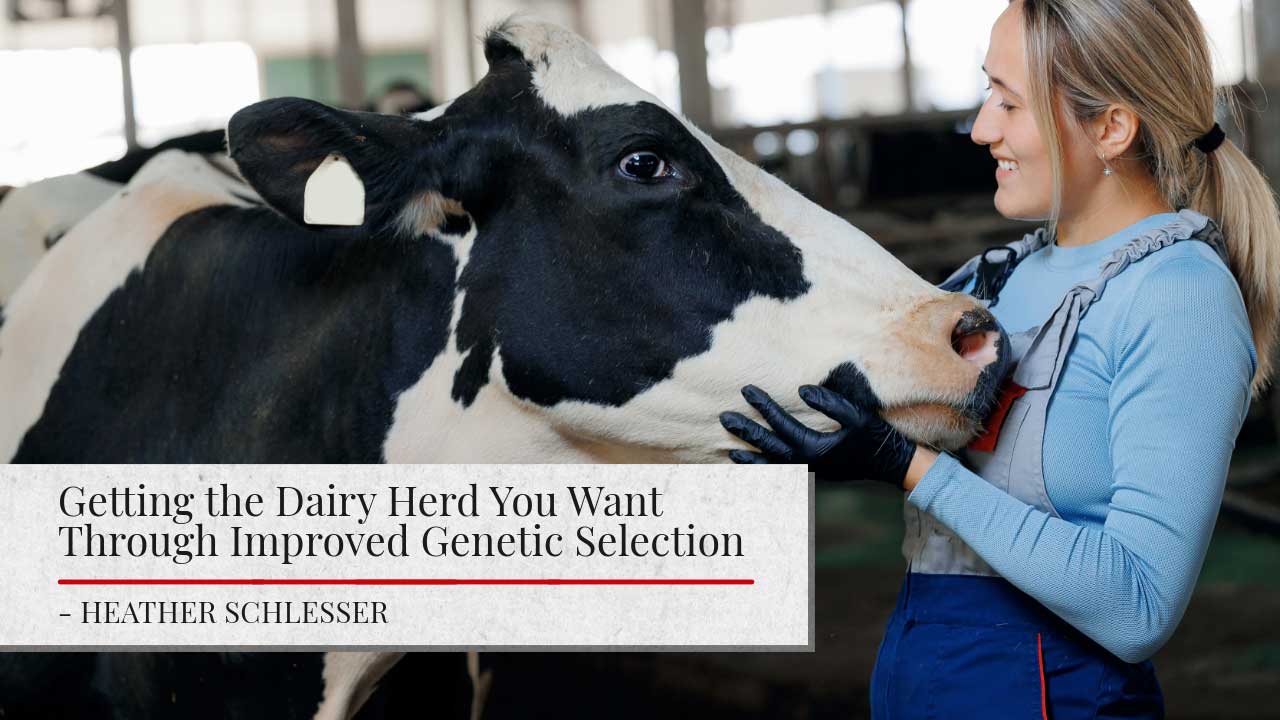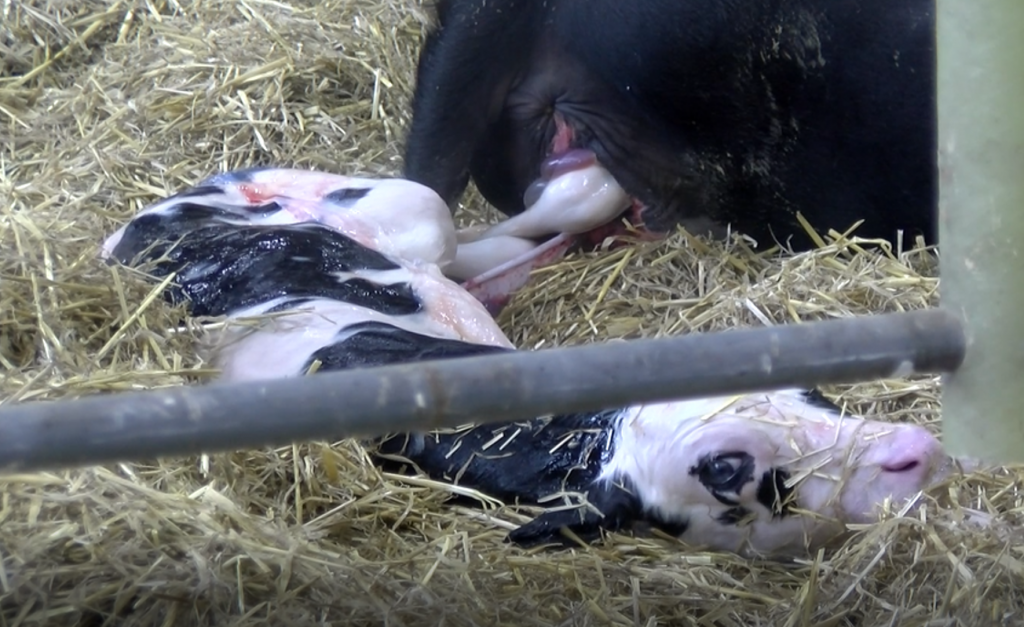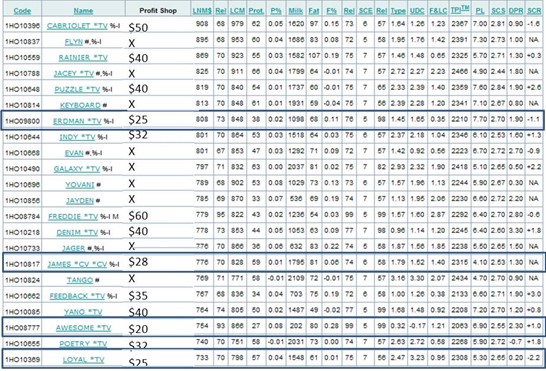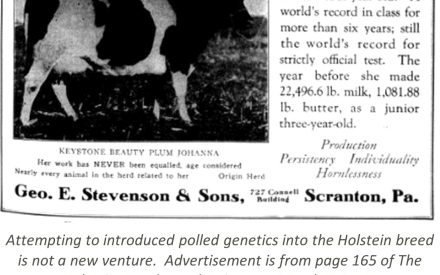English | Spanish
Table of Contents

Introduction
Picking animals for your farm is one of the most important decisions you can make to improve long-term profitability. Whether it is choosing replacements, or deciding who will become parents, without proper consideration the decisions could end up giving you the genetics you did not want. The purpose of this article is to help you understand the principles to position your breeding program for success.
Steps in the selection process
- Determine the goals of the farm
- Increased milk yield
- Increased protein and fat yield
- Select the animals you want to become parents
- Select females you want to keep in the herd and breed
- Review bull proofs and determine which bulls fit with your herd goals
- Determine which sire should be bred to which dam
- Make the correct mating
When choosing who should become parents, or how many offspring an animal should have or the length of time an animal should stay in the herd there are a variety of different variables one could consider. These characteristics range from production traits, such as milk yield, fat and protein percent; to type traits, such as feet and leg conformation. Only you can determine what traits are important for your herd.

Often times a producer will have a goal in mind, and try to pick animals that will help them meet this goal. If a producer wants to increase milk production, they will select bulls with high milk yield Predicted Transmitting Ability (PTA). However, if the farmer has a cow with good milk production and poor feet and legs, they will try to find a bull that has good milk yield PTAs, but also has good feet and legs. This way the offspring will hopefully, still have good milk production, but also better feet and legs than the dam.
Breeding is an art to be learned only by practice, but knowledge of principles supplies the only firm foundation for its practice. Superior animals will be more numerous when breeders know why as well as how.
– Professor V.A. Rice, 1926
How do you determine which animals to keep and ultimately breed?
- Look at the information available on the individual
- Look at information available on relatives
Individual information tells you what traits the animal exhibits. This is only useful for some traits. For example, bulls do not produce milk, so we need to look at data on relatives to determine a value for the bulls.
Pedigree information tells us about the genetic stock from which the animal is produced. Data on siblings is more valuable, because this tells us what has been potentially passed down to the individual. This is known as heritability. The best information is gained when the animal has offspring, because this tells us what the animal is capable of passing on to future generations.
Genomics is a new tool on the market that allows producers to determine the genetic potential of an animal well before the animal reproduces and has production records of its own. Genomics has the potential to evaluate 50,000 genetic markers at one time. When a genomics estimate is created, pedigree information, estimates of merit from genetic markers, the animals own performance records (if available), and progeny’s performance records (if available) are taken into consideration.
Once you have determined which animals to use in your herd one needs to determine which animals to breed together.
Mating Systems
There are six different mating systems that can be used: Random Mating, Positive Assortative Mating; Negative Assortative Mating, Inbreeding, Outbreeding, and Crossbreeding.
Random Mating
Equal chance of mating with any other individual in the population. With this system one does not care which bull breeds which dam, one just wants them bred. (The farmer chooses the sires and dams).
Positive Assortative Mating
Mating best to best, and worst to worst. One would use this system to increase milk production, breeding the best to the best.
Negative Assortative Mating
Mating between extremes. This type of mating results in an animal in-between the two parents. One would use this if one has a dam that is very short/tall and you want her more of a medium height. One could also use this to correct leg angle.
Inbreeding
Mating related animals together. This can help capitalize on traits that you find favorable, however, there are also consequences. As an animal becomes more inbred milk production decreases and calf mortality increases.
Outbreeding
Mating of unrelated animals. With the use of artificial insemination (AI), this is becoming more difficult, as populations around the world are becoming more related to one another.
Crossbreeding
Mating animals of different breeds. The offspring normally benefit from hybrid vigor, meaning that the offspring normally has gains related to both breeds. The first generation cross bred is the best one can get; future generations will not perform as well as the first generation.
The first tool of the animal breeder was the fence.
– R.D. Shanks
Not all bulls are created equal. Table 1 below is an example of one AI company’s bull proofs. Bulls in the $20-$30 range have been selected for comparison. Choosing a bull based on the cost of his semen does not take into consideration your selection criteria. The bull one chooses should depend on one’s selection criteria instead of the cost of his semen. For example, James is the most expensive bull selected below. If selecting on Life Time Net Merit (LNM$), James (776) would not be the bull to choose, because Erdman (808) has a higher Life Time Net Merit and costs $3 per unit of semen less. However, if selecting for Milk Production (Milk), James (1795) would be the bull to select. If choosing bulls based on Daughter Pregnancy Rate (DPR) then the most economical bull on the page, Awesome (2.30), would be the best selection. Knowing which bull to select takes time and careful analysis. Giving your AI Technician a dollar range to choose from does not guarantee you are getting bulls that fit your herd. One may actually be getting bulls that are harder on the pocket book and further from your goals than you expected.

Should I use Young Sires in my herd?
Before a bull has offspring of his own, an estimate of his abilities has traditionally been established based on the average of his Parents’ PTAs. Although parent averages give a good estimate to a young sire’s true performance, it is well known that some young sires will outperform these estimates or even underperform them. Therefore, by selecting a variety of young sires, you minimize the possibility of getting daughters from only those bulls with PTA values below the parent average.
Young sires are currently being selected by AI companies based on genomic estimates. Genomic estimates take into consideration the animals pedigree (Parent PTA values), offspring’s production data (if available), and estimates of merit at various locations throughout the DNA. Research has shown that genomic estimates are more accurate than using parent averages alone. Genomic estimates make using young sires less risky than in the past.
Semen from young sires is often priced below that of proven bulls. Discounted pricing is done to entice farmers to buy the semen. Increasing sales of young sire semen allows semen companies to calculate conception rate, and calving ease on these bulls more rapidly.
Advances in the ability to estimate PTA values allow producers to use young sires with more confidence. Nearly all of the young sires that underperform their estimated PTA, will outperform a Natural Service bull. Therefore, gains in genetic selection are still being recognized when using young sires.
Helpful hints
- If one wants to increase female fertility, one can achieve this through indirect selection for longevity or body condition score, or by direct selection of daughter pregnancy rate (Weigel, 2006).
- If one wants to increase fat and protein percentages, select animals with higher milk yield. While it is true that one gets paid based on percentages of fat and protein, the milk price is absolutely meaningless until you multiply by the number of hundredweights sold.
- When using young sires, use a few units of semen from many different bulls rather than many units of semen from any one bull.
- Clearly decide what type of dairy cow one wants to develop or work with.
- Purchase animals which are already close to the kind of animal eventually desired.
- Recognize the basic concepts of genetics in order to be realistic about desired outcomes.
- Use all the genetic tools which identify sires most likely to produce desired offspring. Furthermore, use selected sires, evaluate their offspring, and make adjustments where needed.
Author

Heather Schlesser
County Dairy Educator – Heather Schlesser is an Agriculture Educator in Marathon County. Heather’s research and outreach have included the use of current technology to enhance farm profitability and sustainability. Her current projects include the Animal Wellbeing Conference, the Midwest Manure Summit, Beef Quality Assurance, financial programming, and teaching farmers throughout the Midwest how to breed their own cattle.
Download Article


 Single Gene Traits in Dairy Cattle
Single Gene Traits in Dairy Cattle Effects of Heat Stress on Dairy Reproduction
Effects of Heat Stress on Dairy Reproduction What kind of dairy cow should you be creating?
What kind of dairy cow should you be creating? ▶️ Watch: Selection of dairy cows for consistent performance under predictable conditions
▶️ Watch: Selection of dairy cows for consistent performance under predictable conditions


